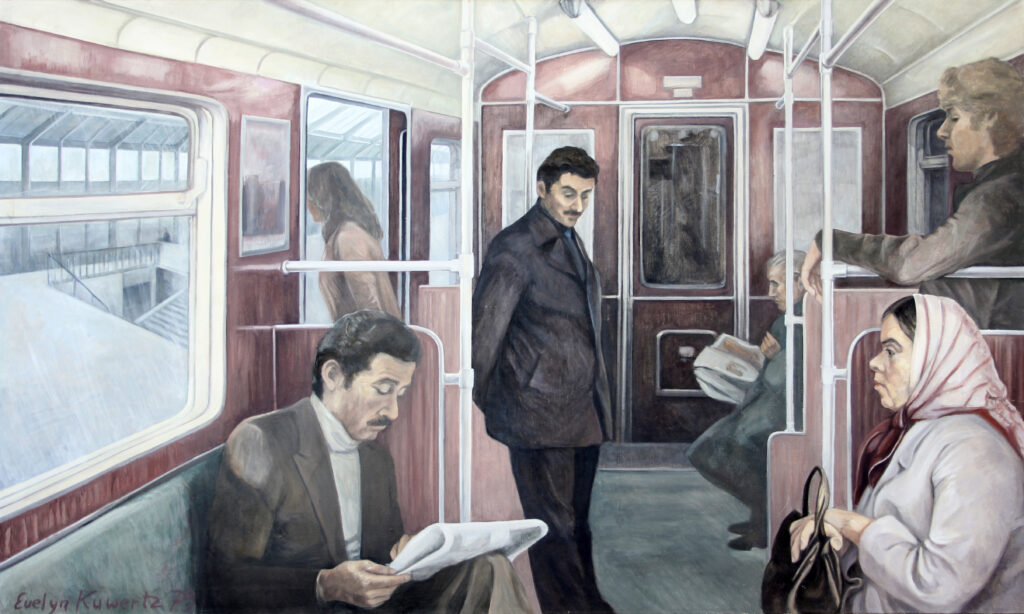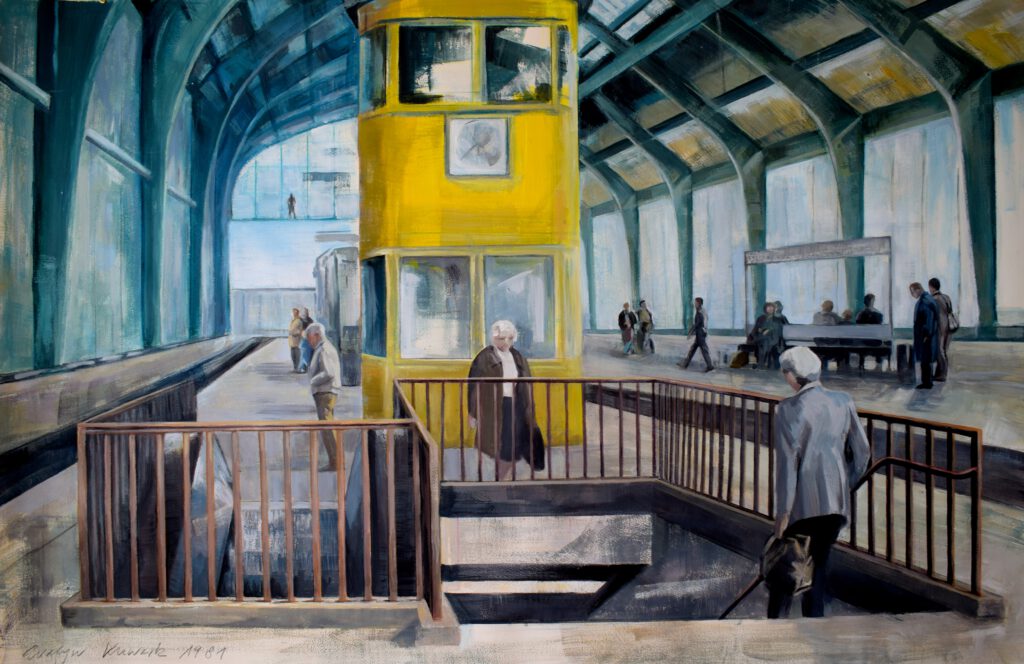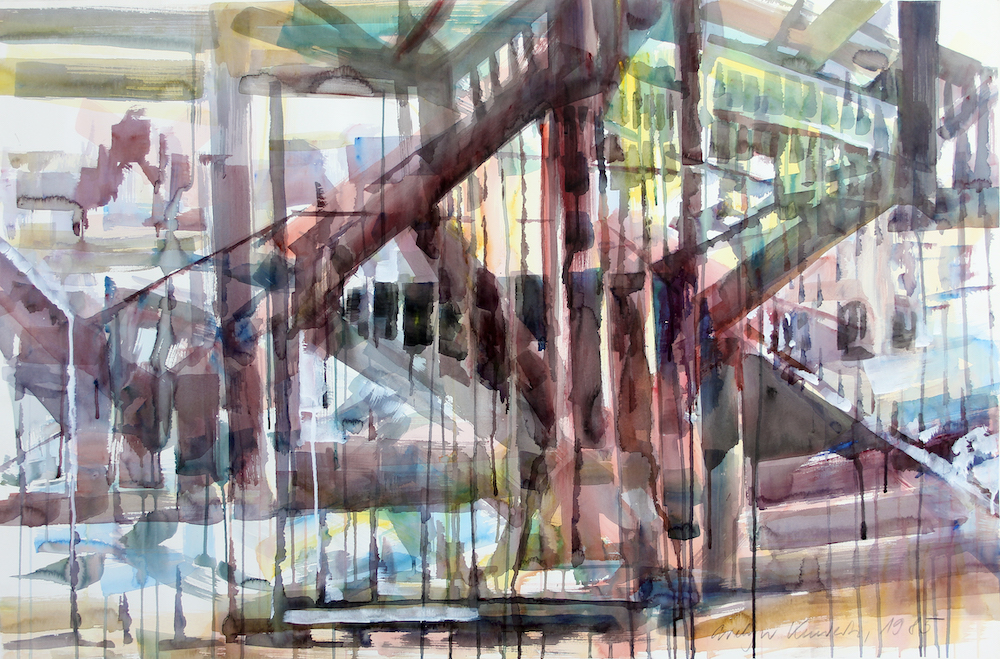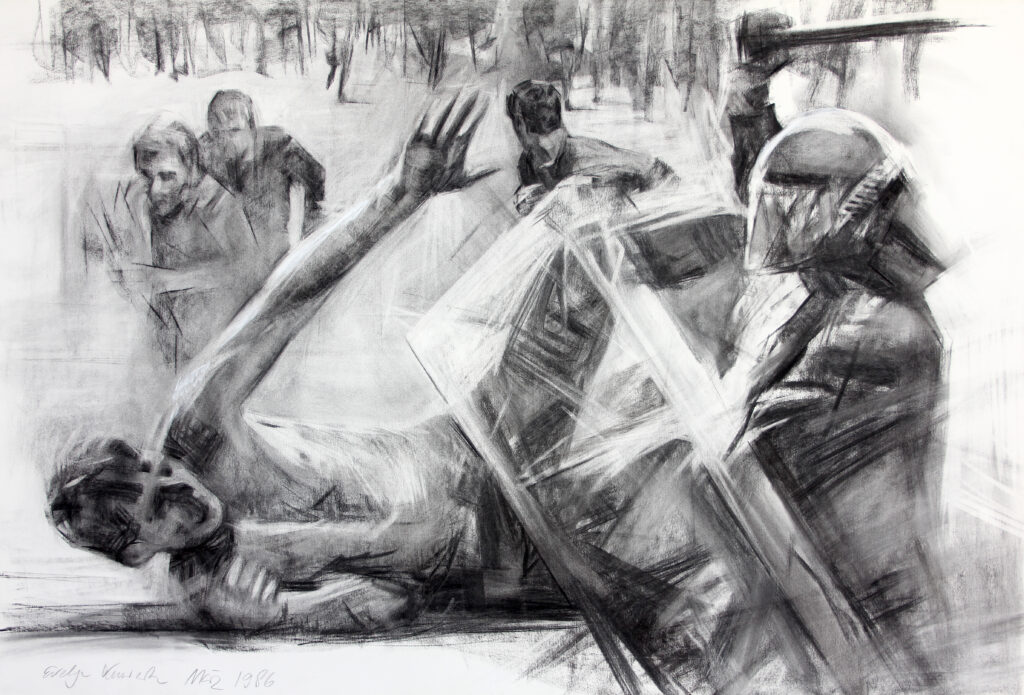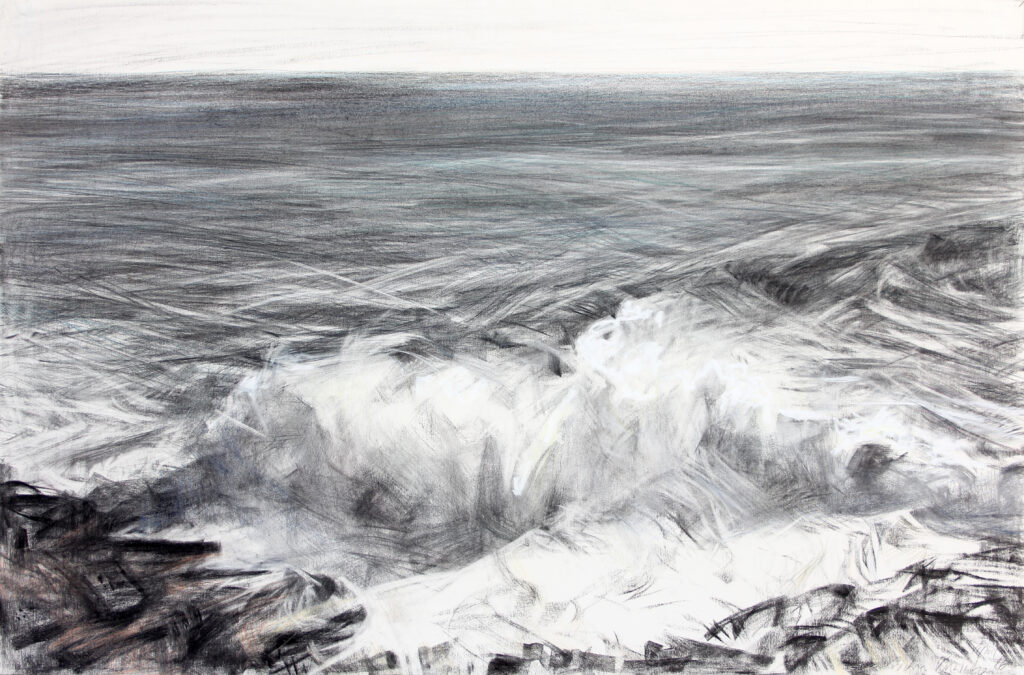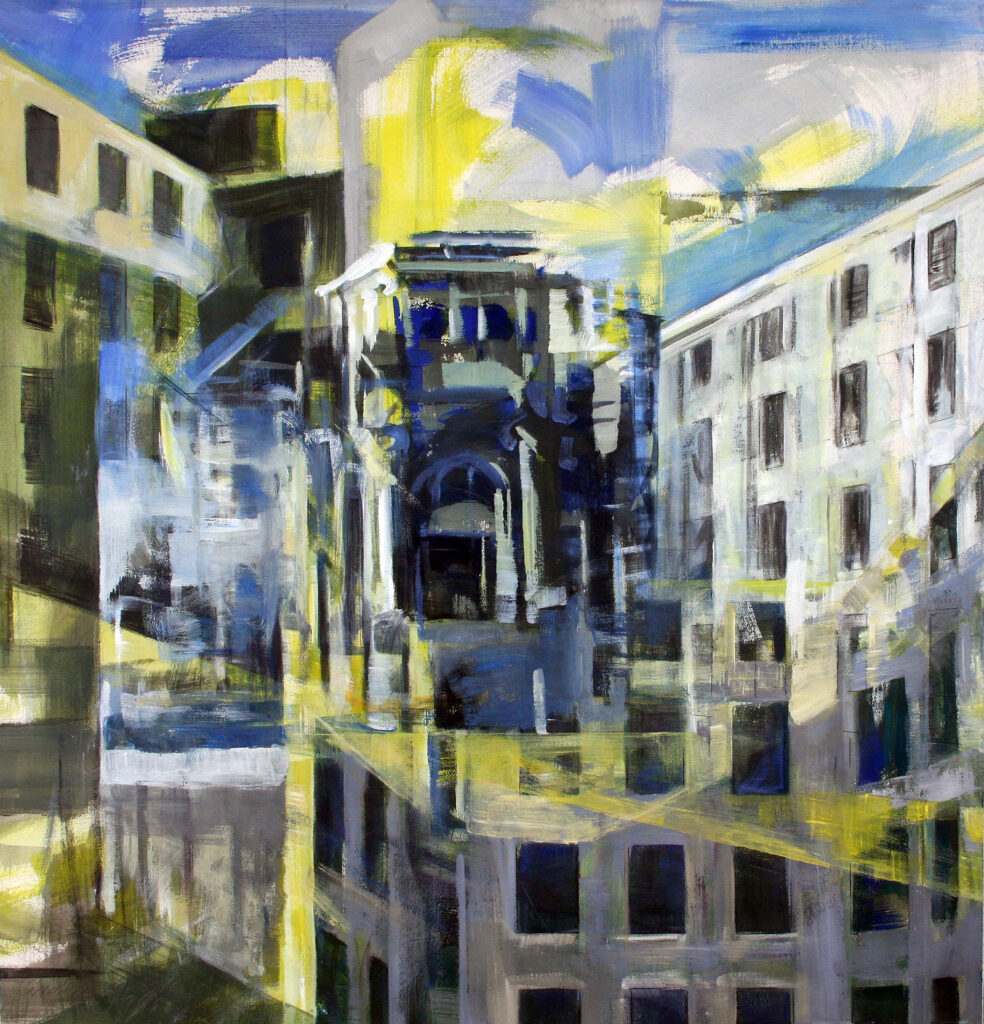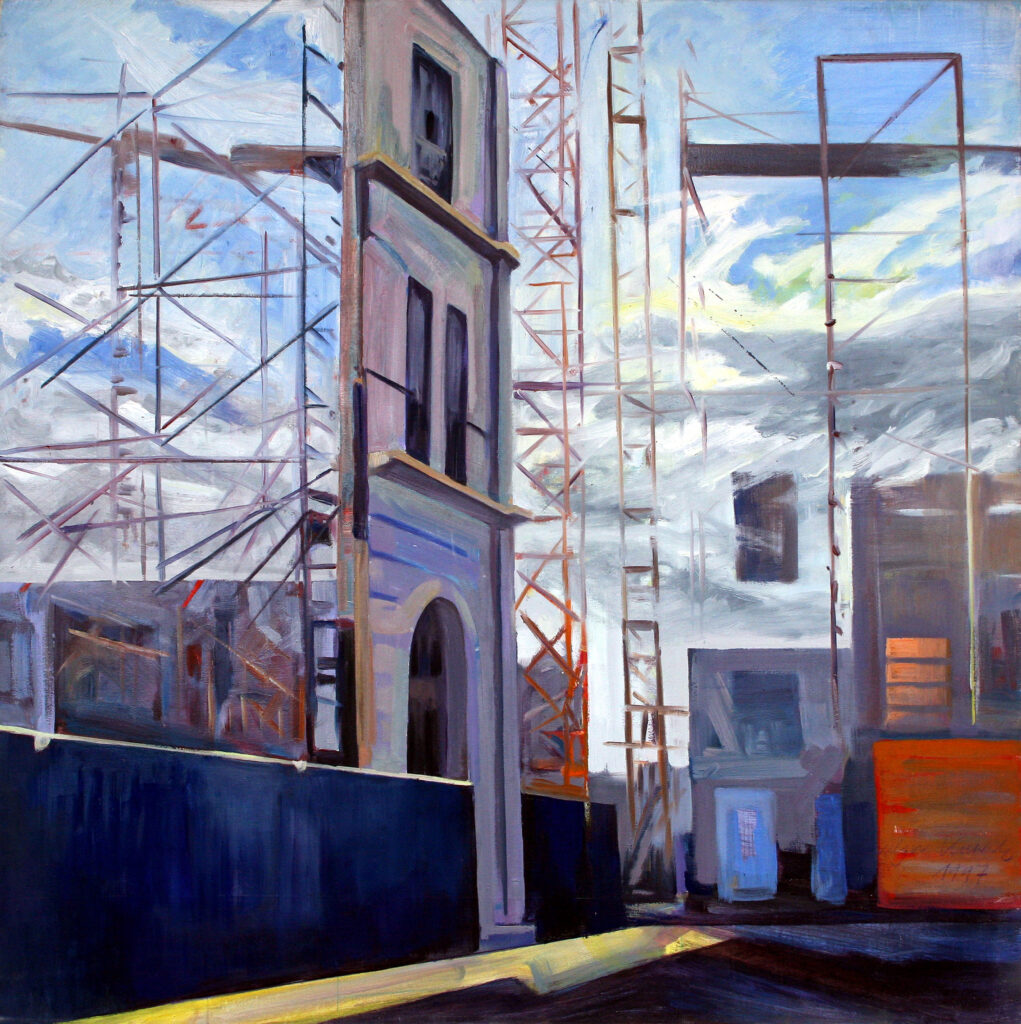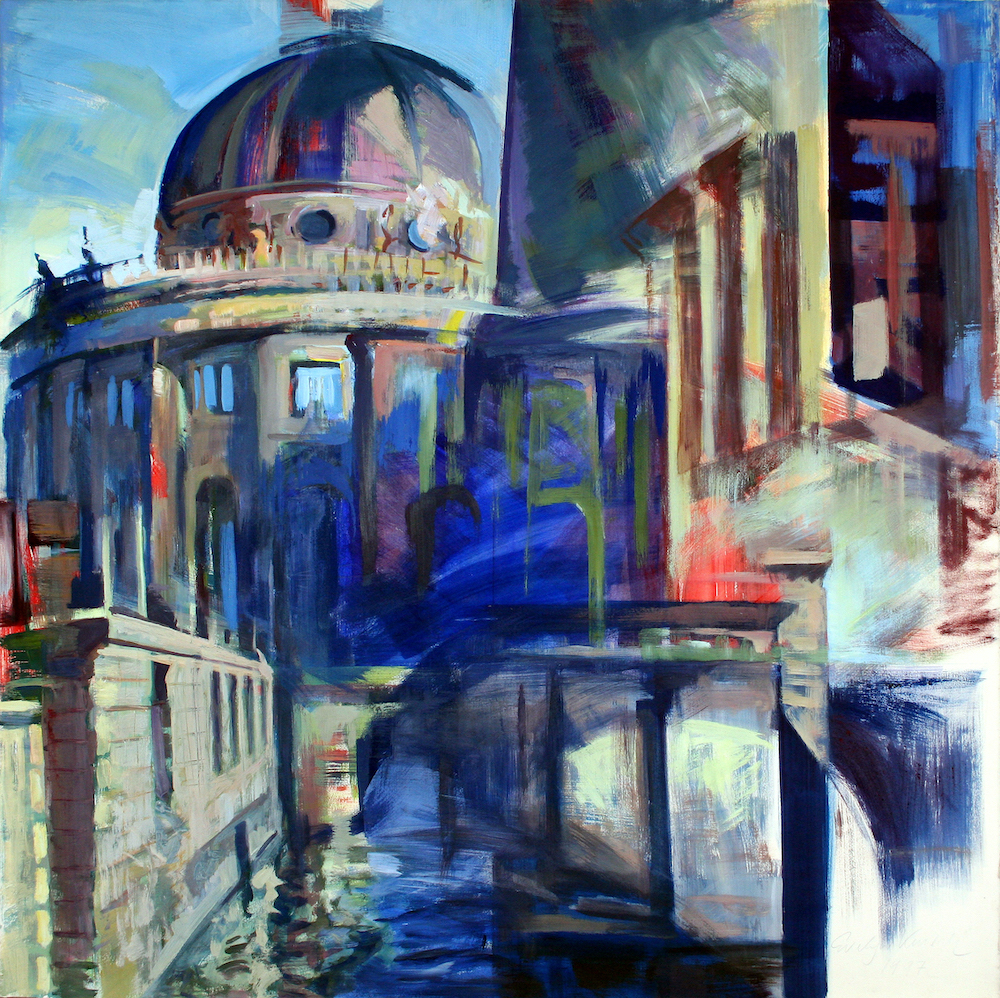Texts / Press
The most preferred topic of EVELYN KUWERTZ figurativ paintings is the Cityspaces – and Images of Man. Her pictures revolve around human existence in an urban environment. The Berlin cityscapes become exemplary subjects, which she transforms into metaphors of time and the ephemeral. Stylistically, it can be assigned to free figuration and realism. The Berlin cityscapes were created over a period of 20 years and show the changing face of the city.
Cityspaces Berlin
Berlin divided 1979-1989
…Evelyn Kuwertz grew up in Berlin in the post-war years, she experienced the ruins, the reconstruction and the era of the Berlin Wall. Since then, perhaps as part of an unconscious process, she has been concerned with the symbolic nature and value of concrete locations. She observes her city with a politically and socially aware gaze…
Ingeborg Ruthe, art-critic for the Berliner Zeitung
In 1979 the city of WEST BERLIN became an ongoing theme: she discovered the U-Bahn (underground railway) and the S-Bahn (urban railway) as characteristic big-city motifs in which the attitude towards life of Berlin residents could be expressed, and which rendered visible the special political situation of the city. She represented urban life of the 1980s by means of the interchange stations of Hallesches Tor, Kottbusser Tor and Gleisdreieck, showing people waiting or hurrying up or down stairs. The light accentuated both the space and also the people who merged with this space. She also painted anonymous, approaching groups of people in a portrait-like manner, as they travelled by U-Bahn or stood on escalators.
…That is Berlin too: cool and closely observed, precisely composed, related to the melancholy scene in Manhattan by Edward Hopper. The expressiveness of Evelyn Kuwertz, like the American, dispenses with a striking tendency. Her pictures speak for themselves – hauntingly, but unobtrusively in a discreet language that doesn’t hide anything, especially not the tragic of a divided city: e.g. the terminus at Friedrichstrasse.
Berliner Morgenpost 13.11.2008
U-Bahnhof Gleisdreieck 1979
90/140cm, acryl, oil / canvas
Bahnhof Friedrichstrasse 1981
80/120cm, acryl / paper
U-Bahnhof Hallesches Tor 1985
80/120cm, watercolor, paper
Drawing
The drawing set me free to engage with the object spontaneously, the direct notation increases the concentration and the intuitive understanding of the structures. In my work on the city of Berlin, I mainly used it as a design technique, to give concrete form to the image idea. The drawing and its related techniques such as watercolor or ink on paper form a continuous component in my work as an independent means of expression. In the middle of thr 80s the historical theme of the City-views Atombunker Kudamm Karree and the „OHNE TITEL“ became continuing and transforming in a elimentary way.
Helgoland 1984-87
In the subject -HELGOLAND- only the drawing is used as a stylistic device. The visit to the island of Helgoland led me to the conception of the pictures with the title – Helgoland -, which I developed against the background of the historical events and the impressions on site (during the 2nd World War the island of Helgoland was completely bunkered as a strategic base In 1947 it was almost completely blown up). This historical background of the island is decisive for the „nature observation“.
…The picture structure is made up of two rows of 4 drawings on top of each other. Black braids of lines cover the upper row of pictures and connect the four sheets across the paper to a grandiose panorama of the sea. The reflexes and movement of the water are completely dissolved in virtuoso lines, which are enhanced with colored accents and their dramatically vibrating effect. Despite the high degree of abstraction, the representation never loses its depictive intent. Although the „Helgoland Pictures“ are drawings in the technical sense and the surface of the pictures are structured by lines and hatching, with the gestural traces remaining visible, the overall effect of the images tends to the painterly. It’s the relationship between the analytical intent of drawing and the synthetic approach of painting that makes the Helgoland Pictures so disconcerting and simultaneously so appealing. The ‘seascapes’ of Evelyn Kuwertz coalesce to form an allegory of time and to visually educate the involved viewer – they become ‘seescapes’.
Dr. Brigitte Hammer, art historian, Berlin
In her Helgoland sequences, representational and abstraction are on an equal footing. The distance between the black and white values is pushed in front of the drama of natural events, conveying a kind of undercooled emphasis.
Susanne Heyden, art critic, Volksblatt, Berlin
Ohne Titel 1985
80/120cm, charcoal / paper
Seestück 1984
80/120cm, charcoal / paper
Slowmotion 1986
100/200cm, watercolor / paper
Slowmotion
At the same time, E. Kuwertz is working on life-size drawings that depict the figure in motion, the slow motions. A mutual influence consists in the dissolution of the motif into movement structures.The object is not grasped by its outline, but from within. The lines and hatchings are drawn freely beyond the shape into the surrounding space, they encompass, concentrate and ultimately limit the body. When viewed from close up, the drawings become movable structures; when viewed from a distance, a real image appears.
…the involuntary expression, the inner tension that shows in the movements of the body, that is the central theme of the Berlin artist.We are confronted with free dance. The dancer’s devotion, the detachment from the floor, the displacement of the heaviness of the body – Evelyn Kuwertz graphically connects this to a linearly linked veil. Through the compression and strength of the stroke sequences, the motif of movement is increased, the flow of lines runs outwards and is left open. The limpness of the body is dissolved in the movement, the connection to the space is established following the force of gravity. Freed from the external, it is possible to understand the human being in his physical expression by discovering his natural and his creative side.
Marché de l’art 11/91
Berlin after Reunification 1989-1999
Major construction site Potsdamer Platz – seen through the eyes of an artist
The dynamic development of the new city center is no longer documented solely through photographs or one’s own perception. Thanks to the Berlin artist Evelyn Kuwertz, who was born in Austria, we see the untidy bearer of hopes for urban planning Potsdamer Platz with completely different eyes … “The bottom is turned upwards, the inside is turned outwards, only the present exists. The question arises as to the nature of change and forgetting, ”writes the artist about her own emotions when the picture was created. And the present is already far away from this moment, the lakes have disappeared, the skyscrapers have grown out of the pits, the first offices have been moved into.
RAST, Berliner Morgenpost 02/01/1998
After the political change, I turned my focus on the process of change around the old / new center. The opening of the Wall on November 9th, at Potsdamer Platz, the now accessible and empty area made possible previously unknown perspectives of the adjacent buildings.Soon the square became a large construction site that permanently changed its shape. the yellow sand broke up, a lake formed, construction cranes and scaffolding enlivened the square. I observed the relocation of entire sections of the facade of the esplanade, the reconstruction of the Reichstag. Likewise Pariser Platz, facades were erected and torn down, scaffolding through which the wide sky fell, the reconstruction of the Hotel Adlon and the spatial renovation processes of the historic city center of BERLIN MITTE. Although the encounters between people from East and West were in the foreground in the public eye, they are absent from these images. Rather, the events are reflected in the changing cityscape. The places became eloquent, the still visible old center of the east was interspersed with colorful signals, a new center was announced. Activity broke the melancholy.
…Evelyn Kuwertz has chosen hard image edits, a kind of montage. She grasps structures, superimposes the sensual and the spiritual in her painterly perspective, and thus creates a painterly topography of the city enabling the momentary to be captured. She concentrates reality to an essence in her pictures, she absorbs and translates through a process of compression, thus creating a new and also sensual reality. Harsh, restrained and with sensitive seriousness, Evelyn Kuwertz reveals the interactions between architecture, people and society. She works against time and forgetfulness by painting the city in a state of flux, before it can close its ‘wounds’. Evelyn Kuwertz’s pictures show Berlin in transition. The changes are immense, and the pictures become contemporary witnesses – free of sentimentality, but nonetheless questioning. For me, her paintings express a mixture of amazement and also uncertainty and thus artistic doubt…
Ingeborg Ruthe, art-critic, Berliner Zeitung
Reconstruction Reichstag 1994
110/100cm, tempera / paper, marouflée
Hotel Adlon 1995
90/90cm, oil / canvas
Île aux Musées 1997
130/130cm, tempera, paper / marouflée
Museum Island and the New Museum
Mage motifs are the exterior views of the buildings from different urban development epochs that make up the historical Museum Island.
I prepare on-location sketches of the gutted remains of the inner spaces. The light floods the building stors and structures the architecture and the supporting pillars with its shadows. A moment of calm – only the red scaffolding pointed to the coming construction work – in which faded beauty could be intuited and the destroyed sculptures can be imagined. The various rooms are depicted in a series of paintings and mixed techniques on paper, and the method of montage is used to intersperse the building’s current state with historical quotes, for instance the Greek Courtyard with the Schievelbein frieze.
Potsdam
Potsdam Perspectives by a Woman of Berlin: Evelyn Kuwertz in the Autumn Salon
…The works by Evelyn Kuwertz, Berlin, are among the most interesting…
…Architecture, especially here in Potsdam, doesn’t only mean palaces and gardens but also many building styles and new buildings under construction. The past and present collide, but also enter into a symbiosis. Kuwertz’s pictures are powered by these transitions and fractures, by the contrasts. The artist’s background is in critical realism. But these works are not about precise, strict lines. Instead, a representationalism tending towards the abstract communicates the opposite through lines of a more flowing nature. Her startling compositions in impressive coloration – she calls them “Potsdam I-III” – are interpretations intended to provoke thought and interesting interactions, in which the viewer, through imaginative connections and the recognition effects, because co-creator of the pictures.
B.W., excerpt from the newspaper Potsdamer Stadtkurier, 1998
www.evelyn-kuwertz.berlin
European Cities
Since 2000, Evelyn Kuwertz has also observed, and found inspiration in, in other european cities: PARIS, BARCELONA, ROME and created a series of pictures from TOULOUSE in which countryside she lives. It is not the point of view as a chronicler or with the intention to illustrate the reality -basically of this works is the subjective impression and emotion, she had at the first sight, and the special light in each city reflecting the architectural forms.
Toulouse
From 2000 onward, the European city of TOULOUSE provided a visual subject. Fascinated by the urban architecture, EVELYN KUWERTZ set out to discover the city. The series dealing with TOULOUSE is not executed from the perspective of a chronicler, nor can one recognize an intention to depict reality; she follows her first impressions, the special aspects of each city, its colors, forms, light and atmosphere. It is subjective perception and experience that provide the motivation.
Attracted by the unfamiliar architecture and colorfulness of the city, which to me also seemed strange, I applied the gaze of a flâneur, opening myself to the impressions without any intention and letting myself be guided by the light which lent form, structure and color to the objects. For a moment the unfamiliar city revealed itself, and then once more hid away its secret essence. Reality and imagination intermesh; subjective perception remains the determining factor for my interpretations of other European cities too: PARIS, BARCELONA, ROME.
Rome – tribute to Caravaggio
In the watercolor and the oil painting with the title ROM, the buildings of the city and a quote from art are combined in the form of a montage, on the one hand the city is depicted and at the same time its cultural tradition – if I think of Rome, I also have the paintings and sculptures of the city in front of my eyes. In the pictures, the various visual elements are bundled, the bright light in a large square, the massive buildings in silhouette and in a perspective. In the foreground of the picture St. Paul who is in the fall is shown, the figure taken from the picture “The Conversion of Paul” by Caravaggio (Collezione Odescalchi Balbi) Rome. These Rome compositions, using the grisaille technique, convey a melancholy basic tone of transience.
Mouvement
One variation of this theme is the set of images Movement before the city which concerns a person’s movements within his or her urban environment. The bodily movements either correspond with, or contrast with, the fragments of the city. People come to seem more real.
Reinterpreting the approach „pris sur le vife“, Kuwertz does not choose one medium in which to perfect representation of the human body „from life“ but instead experiments – „sur le vif“ – with mixed techniques, ranging from drawing through paintings to montage and across a variety of formats. The resulting figures are surprisingly concrete, even personal. Hints of clothing render the figures in here and now. Uniting Kuwertz‘s lifelong artistic engagement with the bodies and cities, fragments of urban spatial forms overlap with intertwined intimations of human movement. The composition remains transparent. The dance canon of movement meshes with the space, the light, in these works. The comprise a synthesis of sculptural poignancy.
Répétition
Twenty years after she had first begun to work with dancers on dance, Kuwertz turned again to the human body and created RÉPÉTITION, a new series of paintings. In 2004, after attending rehearsals for the dance pieces „Sacre du printemps“ and „Orma“ at the Ballet de l‘Opéra, Toulouse. In 2006 she used silksceen technique to strike variations on this theme.
In addition, Evelyn Kuwertz is inspired by dancers but her subject is neither dance nor the dancers but the elements of movement. A double movement: the improvisation of the dancers in space and of the pencils and paintbrushes on cardboard, paper and canvas. In the finished works we sometimes see a face, a hand or a curve signifying a bodily curve. But these are not static portraits of posed models at a fixed moment in time. They are images of the constant changes made in order to recreate and liberate their essence. The different phases and traits of movement are recorded by the painter to give the spectator images of movement. The aesthetic attraction is revealed in a concentrated image which is fixed on the canvas in a fugitive and sketched manner. Throught its direct notation on the canvas, the movement becomes a graphic element which remains on the paper like the trace of an interior impulse.
Christian Schmidt, painter and author, Toulouse
Répétition pris sur le vif
2008 she follows the dance piece „Caravaggio“, Staats Ballett Berlin. Numerous watercolors are created during rehearsals for the ballet, which translate the movement elements of modern dance directly into elements of paintings. Because of the quick, intuitive comprehension of the dance with a brush and colored pencils, the effect is abstract: body forms dissolve in mouvements on the paper. The lines reflect the expression and dynamics of the performances.
Woodcut
I discovered old oak boards in a dilapidated barn. They were boards cut from the trunk, in their growth and shape I saw parallels to the line structures of my earlier drawings: the slow motions. This find inspired me to reconnect with the “pris sur le vif” and transfer it to the woodcut. This technique, which was new to me, was a challenge, because the pressure removal from the long boards was only possible by hand. I experimented with different color combinations on Japanese paper and tracing paper. Because of the uneven surface of the grained wood, the printing inks are absorbed differently. Which also gives the prints a special charm and liveliness. Each print is unique.
Nature Observation
The topic of landscape aroused my interest through the observation of the daily changing light moods in the morning, within hours, I began to capture these moments spontaneously in small oil sketches. This series of images shows the impressive spectacle that goes on in front of the window every morning. The night slowly recedes as the day appears on the horizon and illuminates the Pyrenees mountain range with its light. The light rhythmics the landscape, which takes on contours out of the darkness. A different color composition every day. A series of daily observations, compiled from January 1st to February 9th, 1999 result in the first picture composition.
Meditation Matinale
Depending on the occasion, I continued the theme of, for example in pictures that I realized between the holidays at the turn of the year. In winter 20/21 I paid more attention to these nature observations. This constantly changing sequence of images, which is never the same, neither in the changing nuances of the colors or the contrasts. I wanted to understand from a structural point of view and also to work out different techniques and formats.
Portrait
In 1979 the city of WEST BERLIN became an ongoing theme: she discovered the U-Bahn (underground railway) and the S-Bahn (urban railway) as characteristic big-city motifs in which the attitude towards life of Berlin residents could be expressed, and which rendered visible the special political situation of the city. She represented urban life of the 1980s by means of the interchange stations of Hallesches Tor, Kottbusser Tor and Gleisdreieck, showing people waiting or hurrying, the light accentuated the space and the people. Anonymous, groups of people she painted in a portrait-like manner, by U-Bahn driving or standing on escalators. 2011 Evelyn Kuwertz starts the theme portrait, faces taken from meetings every days – events- news. Portraits Urban, Self-portrait, Adolescence.
Selfportrait
2014 E. Kuwertz continues the examination of the self-portrait witch she has varied in different context, in the 70s and 80s Years. In the new works is the pictorial implementation the modulation of the face by the incident light.
